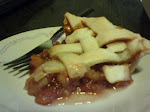The origin of Gingerbread dates back to ancient times when the spice "ginger" was known for its medicinal properties, often used for curing stomach aches. Small gingerbread cakes adorned with symbols of the sun were made to celebrate the Winter Solstice in pre-Christian Europe. Catholic monks baked gingerbread for special religious celebrations. The cakes were constructed in specific designs depicting saints and religious motifs. The early carvings were made with a large and elaborately carved "cookie board" that impressed the pattern onto a stiff rolled dough. As the costs of exotic ingredients and spices dropped, gingerbreads slowly became more popular across Europe and Britain. The English added bread crumbs to the recipes. In the 16th and 17th centuries, gingerbread became lighter, with flour replacing breadcrumbs in the recipes. As early as 1573, molasses was used instead of honey and by the mid 1600s it had replaced honey altogether. Butter and eggs became popular additions to enrich the mixture. The first gingerbread man is credited to the court of Queen Elizabeth I, who impressed important visitors with charming gingerbread portraits. The tradition of baking a Gingerbread House began in Germany after the Brothers Grimm published their collection of German fairy tales in the early 1800s. Among the tales was the story of Hansel and Gretel, children left to starve in the forest, who came upon a house made of bread and sugar decorations. ~ Chef Wilkinson ~











































